#belle french zine
Text
HAPPY EVER AFTER: RUMBELLE ZINE

Are you a OUAT Fan?? Do you love Rumbelle and their love story?
Then, this is your project!
This is a NON-PROFIT Project, focusing on Rumple and Belle's love story up to their happily ever after.
If you are interested, please fill up this Form and please spread the word to fellow chipped roses!
╰⊱♥⊱╮ღ꧁ ✿ ꧂ღ╭⊱♥≺
Link: https://forms.gle/o2FLNwtQwWVd6SCy7
#rumbelle#rumbelle zine#rumbelle fanzine#ouat zine#ouat#once upon a time#once upon a time fanzine#interest check#rumplestiltskin#rumplestilskin x belle#belle french#belle french zine#rumbelle fanart#rumbelle fanfic#ouat fanart#ouat fanfiction
16 notes
·
View notes
Text
common flowers names + french forenames BUT excluding "ç"
Agnoît Alia Alie Alleille Allenoît Alles Alley Allie Alowbe Alyptus Alément Alérène Amic Amine Ancine Ande Ander Andylas Anichria Anium Aniumpe Anlus Anmadine Annevine Anniève Appette Appy Aragalm Argette Aricam Arien Arine Arkspint Ascine Asily Asmilde Assia Asta Aude Aules Aulia Aureyss Aurn Azandrie Bale Balli Bappette Baptin Basmica Begonis Bele Belexave Belia Belis Bell Belline Bern Berry Blanget Bluc Blucis Bluck Blum Blup Blus Boranis Born Bria Brice Brogette Brow Bush Butia Butillet Butte Béane Cabruff Cacel Cacon Caconque Cacquel Caline Calle Calm Camélène Canium Canne Carc Cariste Carte Cath Catriel Catrien Chamose Charther Chriant Chrictoe Chrie Chrient Chrin Chry Chryline Chèle Clacore Claette Claul Claulia Clobe Cloe Clémi Clémin Clérieu Cole Coline Conis Corger Coria Corickly Corilick Corne Cory Cose Cotis Cower Croles Crore Crosé Cycle Cyrie Cyrigon Cyris Cyrte Céath Cédreory Cédrine Cédérine Célicell Célis Daff Dafforne Dahlovel Dail Daine Damenzo Damore Dancille Danksh Davide Dayfe Delien Delle Dellette Denia Denne Dette Dine Dylvie Dylvin Dylvine Emone Fabie Fabrops Fabrunip Fange Feand Floben Floric Flove Flyhock Fodom Foricari Foris Frah Frame Franine Fraphine Frarion Frawbert Frayfer Frée Galaudin Ganince Garie Gary Gaétia Gaétis Gaël Geange George Geste Gette Gine Gistia Gitia Glania Glaur Gloe Gramarc Guelivy Gélieu Hemart Hisèle Hoce Hocélène Holil Holuck Honie Hoon Hoose Huguelle Hyan Hydia Hydrole Hysanick Hyss Hysuck Héranip Hérèse Inge Iren Irenis Irias Irick Irimrose Jacine Jamon Jand Jasia Jaster Jeacis Jeance Jeand Jeane Jeange Jeanksh Jeanloé Jeannise Jeanny Jeant Jenic Jone Joninet Jony Joses Jossion Joste Joëllame Jule Julis Jush Jushry Kaël Kaëlle Kaëllia Kerre Ladelier Lailbus Laine Land Lane Lanue Lara Laud Laulia Laurie Laurole Lavia Lette Lien Lieu Lilint Line Lione Livy Lober Louil Lower Lowerie Lowert Loémi Lucamis Lucath Luck Ludin Ludine Lupic Lybus Lyptian Léme Lérène Magary Mage Maine Mainie Maire Maise Mand Manick Marce Marcia Mard Marde Mariene Marieu Marjose Marline Maroger Mart Martria Mascie Matine Matmen Matrick Matris Maum Mierc Miletpe Mine Miscatie Missa Miste Mium Momilien Mone Monia Moniaste Monie Monksh Monkspie Mony Mood Moodilia Morara Morie Murthéo Nadiosee Nasmic Natia Natricen Niange Niquel Nium Notised Ocevine Ocupier Odintia Olette Olisy Ollien Ollistle Olue Olup Oreine Orniene Palette Pane Pastie Pastren Pathine Patinne Patte Paud Paulia Paulily Paum Paura Paurn Pette Phen Phine Pienelic Popsia Prien Prifen Prinel Quetis Rane Ranife Renny Rentium Renzo Rhole Rhose Rhosmon Rober Roless Rolil Rolus Régon Rélion Rélippy Sabiené Sabiste Sabrier Sabrop Sabrum Same Sane Scac Scanta Shris Silde Simpette Siolder Smilee Snatra Snole Snot Sone Sopplen Stine Stiumel Stre Swee Swer Syla Syline Sythia Ther Thevis Thie Thile Thilvier Tuft Vaine Vale Vallip Valm Valémi Vielyoft Vine Wild Wilyne Wood Xavin Yacora Yane Yanne Yvennie Zine Élie Éline Érole Éves
0 notes
Text
TOGETHER AGAIN SPOILERS
A thread of lore, Easter eggs, episode connections, and background details from Adventure Time: Distant Lands: Together Again! Let me know if I missed anything! This is adapted from my original Twitter thread.

Keep reading ⬇️⬇️⬇️
1. I was expecting them to perhaps do a classic style title sequence for this episode, but I wasn't expecting them to straight up use the original title sequence. The only difference is this final screen saying "Distant Lands".

2. The background of the title cards is also the hill from the title sequence.

3. The ice cream having "50 flavours" and having an image of an enlightened soul is an obvious reference to the 50th Dead World as we see it later in the episode.
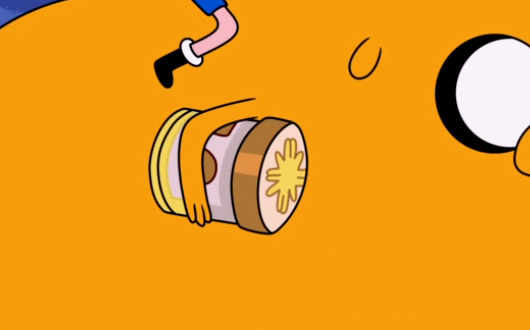
4. Continuing with the metaphor, the dirt in the ice cream could be a parallel to the fact that Jake's Nirvana actually wasn't perfect, because his inaction was allowing for injustice to perpetuate.

5. This whole scene feels immediately slightly off. Finn has his Scarlet sword and is out on a classic Ice King adventure, but he speaks in his grown voice and all the slang feels much more forced than it did in the real season one. Turns out this was deliberate.
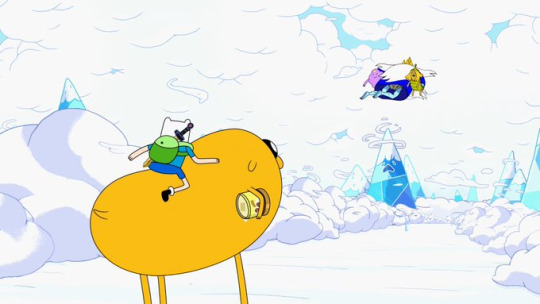
6. The snow golem speaks with a baby voice like it did in the pilot episode, even though in canon it has a deeper voice. This further hints that something is not quite right.

7. The first major break in continuity is these snow golems resembling Uncle Gumbald and Peace Master, who Finn didn't meet until later in his life.
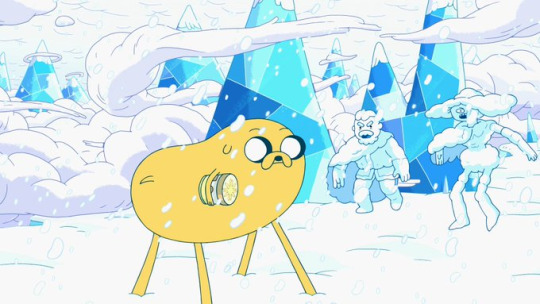
8. LSP sitting on Finn's head like this is reminiscent of Pen Ward's piece for the 2018 Ble crew zine.

9. Finn being given the choice of helping somebody but ending up helping everybody reminds me of "Memories of Boom Boom Mountain". It's the kind of resolution that wouldn't happen so much in the late seasons of the show, which helps make this scene feel even further out of place.
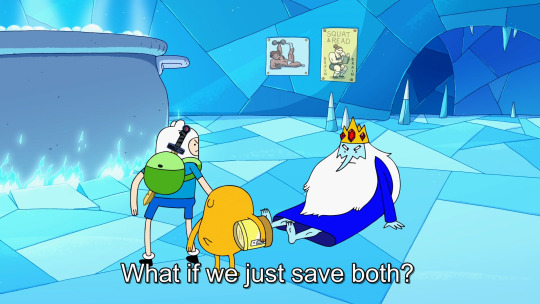
10. Jake is half frozen by Ice King in pretty much the exact same way as he was in "Prisoners of Love", and even has a very similar line.
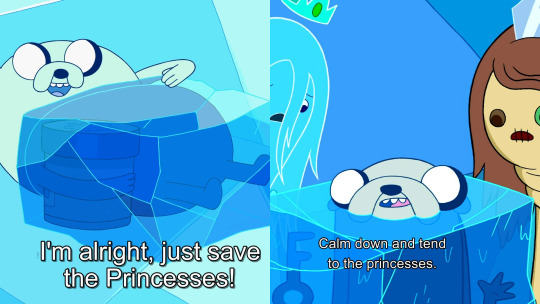
11. The Snail is seen here. The crew have said that the Snail has been deliberately left out of previous Distant Lands specials, so its placement here is another very deliberate hint that this whole sequence is "trying too hard" to be like the early seasons.
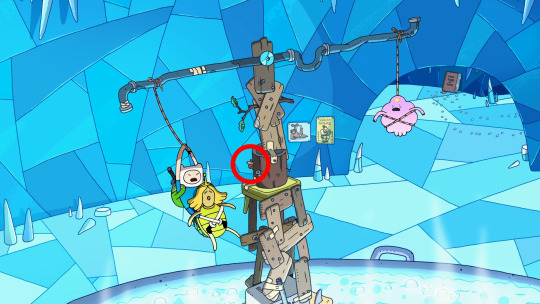
12. The book "Mind Games" appears a couple of times, as seen in several previous episodes of Adventure Time. The first is as Finn is approaching the library in his dream. It also appears as one of the items in Finn's backpack later.
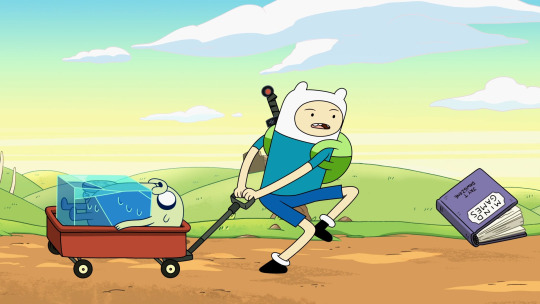
13. Jake is hurt when Finn fist bumps him with his metal arm, revealing that this scene is not real. This is also a callback to the title sequences of "Islands" and "Elements".
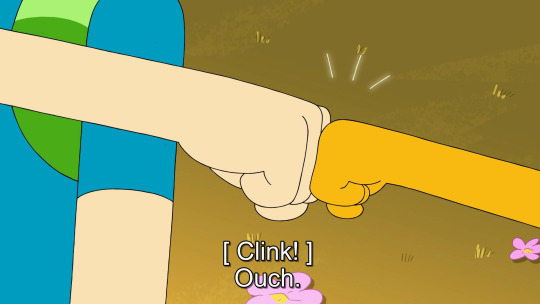
14. A whole bunch of familiar skeletons are seen in the bird's nest: Dirt Beer Guy, Abracadaniel, Me-Mow, Lemongrab, Mr. Pig, and the Snail again. This doesn't necessarily mean that all these characters are dead, since this scene is just a hallucination.

15. Old Man Finn! He's still got the chest tattoo of Jake, and this time we know that Jake is dead, so the theory that Jake died before "Obsidian" seems pretty likely. He looks similar to his old man design from "Puhoy", with the same facial hair.
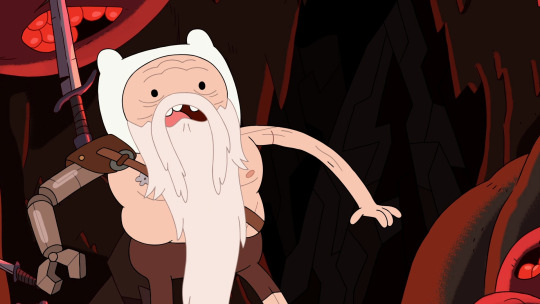
16. There are several cameos of familiar characters who apparently died at the same time as Finn. The first is this duck, who previously appeared in "Ocarina".

17. The second is Donny, from the episode... uh, "Donny".

18. This goblin guy is an unnamed background character from “The Silent King”.

19. This old lady first appeared in "The Enchiridion", way back in season one. Old ladies are a species in the Land of Ooo, so I guess she wasn't actually very old back then, given she just about outlived Finn.
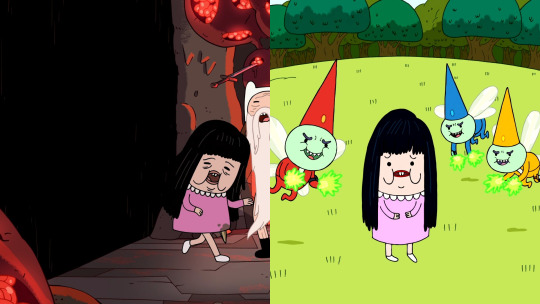
20. This is the cobbler who first appears in "His Hero". Amazing that he lived so long given all the trouble he got into in that episode.

21. Land of the Dead! This place was first seen in season two's "Death in Bloom", and now we are finally learning its actual purpose. It's a sort of gateway and hub to all of the other dead worlds.

22. There are some more minor cameos at the gates: a house person from "Donny", a soft person from "Gut Grinder", and a wood person from "When Wedding Bells Thaw". And, of course, the gate guardian himself from “Death in Bloom”.

23. Finn completely ignores the gate guardian in the same way he did in Death in Bloom. This also has the convenient effect of not having to reveal how Finn died, leaving it up to the audience's imagination.

24. Mr. Fox! We already knew he would die at some point because BMO had his skull in the finale.

25. Finn has his design from the first Distant Lands poster in this scene. Turns out it's young Finn in old Finn's clothes. But they gave him a shirt in the poster so you wouldn't be able to see the tattoo.

26. The clapping that Finn does while he's looking for Jake is a callback to "James Baxter the Horse", when Jake tells Finn to listen for that same rhythm if they are killed and need to find each other in the afterlife.

27. Mr. Fox talks about a "past life quotient", suggesting that there might be some kind of limit to how many times somebody can reincarnate. Finn's reincarnations are also seen in this scene; a callback to "The Vault", and confirmation that reincarnations share the same soul.

28. Boobafina, the goose who Mr. Fox was in love with in his debut episode “Storytelling”, apparently reincarnated into a tugboat. We've already seen that objects can have souls in the episode "Ghost Fly".
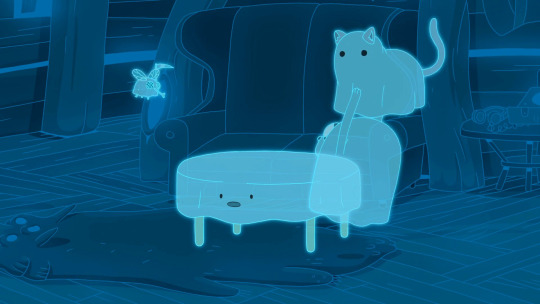
29. Finn is initially assigned to the 37th Dead World, which is the same one that Jake went to when he died in "Sons of Mars". We can only guess at what the other numbers on the ticket mean ;)
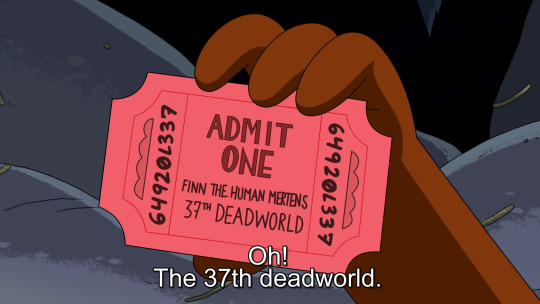
30. Tiffany! Despite several lucky escapes throughout his life, Tiffany has finally died. I like the use of this imagery to express Finn's conflicted feelings about him.
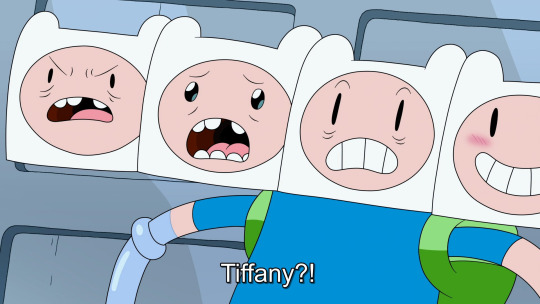
31. The 50th Dead World has long been established as the "highest" dead world, and the one synonymous with Heaven within Adventure Time's universe. It was first mentioned in "Ghost Princess" back in season three.

32. It's unclear what happens to souls which are destroyed within the dead worlds. It is a similar question to asking what happened to the ghosts that were killed in "Ghost Fly".
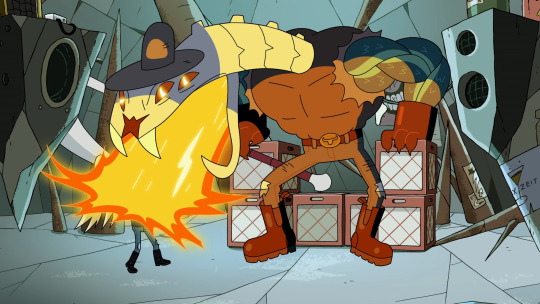
33. Death doesn't speak at all in Together Again because his voice actor, Miguel Ferrer, passed away in 2017 long before production began.

34. Finn phases through New Death when he tries to attack him, just like what happened way back in "Death in Bloom".
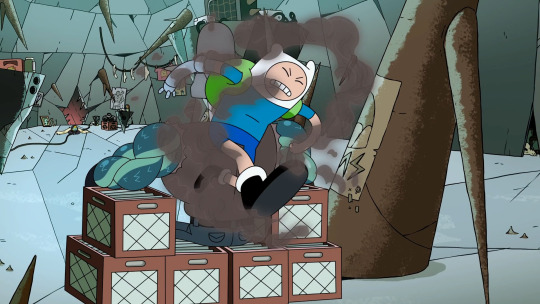
35. The 30th Dead World contains Tree Trunks as well as many of her love interests; Mr. Pig, her alien husband from "High Strangeness", Danny and Randy who first appeared in "Apple Wedding", and several more who we don't recognise, including at least one who presents as a woman.

36. Literally yelled when these two showed up. Joshua calls Finn a crybaby, which is a callback to "Dad's Dungeon".

37. The wall of weapons in Joshua and Margaret's house includes the iconic Demon Blood Sword, which was broken in "Play Date", as well as Margaret's auto-loading crossbow from "Joshua & Margaret Investigations".

38. Jermaine is sidelined a few times through the episode, in reference to his attitude in "Jermaine" where he feels that Finn and Jake were always their parents' favourites. I would have hoped things would be a bit better by now.
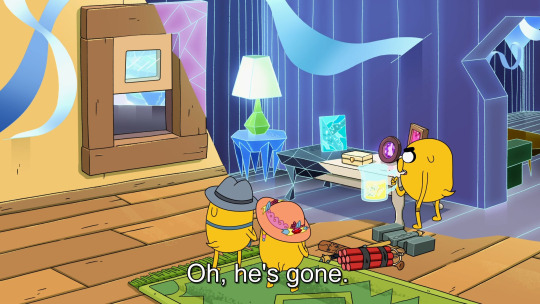
39. Fern gets name dropped while Finn and Jake are reuniting. A shame he doesn't actually show up in the episode.

40. In this scene, Finn says "What time is it?" This is a very subtle reference to the 2010 cartoon "Adventure Time".

41. In a couple of shots during this fight scene it looks like Jake might have a tattoo. It seems like it only becomes visible when he stretches out his arm.
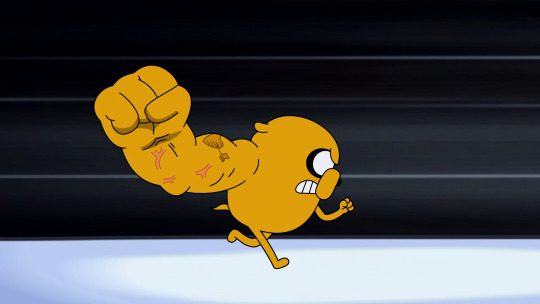
42. New Death's amulet in this scene resembles parts of the Lich's cape, foreshadowing his influence on New Death.
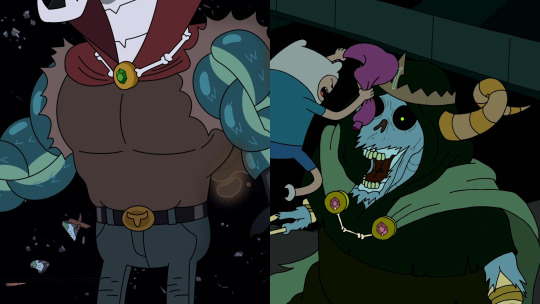
43. There are several more cameos in the 50th Dead World: Booshy from "High Strangeness", one of the Marshmallow Kids from "Scamps", and Ghost Princess and Clarence, who were seen ascending to the 50th Dead World in "Ghost Princess".
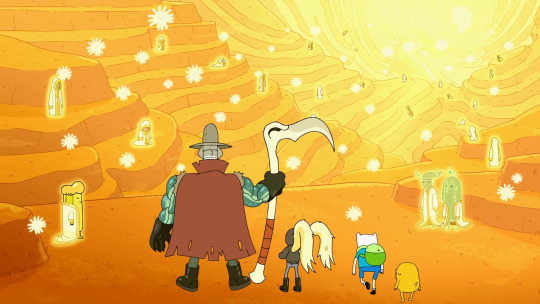
44. Finn didn't interact with Booshy in "High Strangeness", but it seems they must have met at some point before they both died because Finn knows his name.

45. It seems like people in the 1st Dead World are slowly melted away until they become part of the landscape. Nasty.
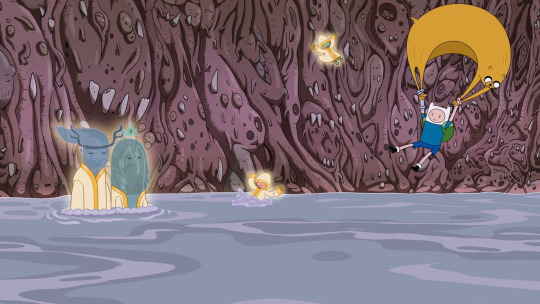
46. Lots more cameos in this scene: a gnome from "Power Animal", a gnome from "The Enchiridion", a Bath Boy from "The Vault", Blagertha from "Love Games", Maja the Sky Witch, a troll from "Dungeon", Chocoberry, Choose Goose, Wyatt, a spiky person from "Gut Grinder", and possibly more.

47. Tiffany's insults are consistently nonsensical and amazing, as they were in the original series.

48. The Candy Kingdom looks extremely different. Peppermint Butler is wearing the crown so he might be in charge now, which is supported by the kingdom's very magical-looking augmentations. It’s not clear whether Finn and Jake were expecting to find Princess Bubblegum or Peppermint Butler, since both have the initials “PB” and both could be going by the title of “Princess”. Perhaps Peps and Bubblegum share the princess duties now that PB is living with Marceline more of the time.
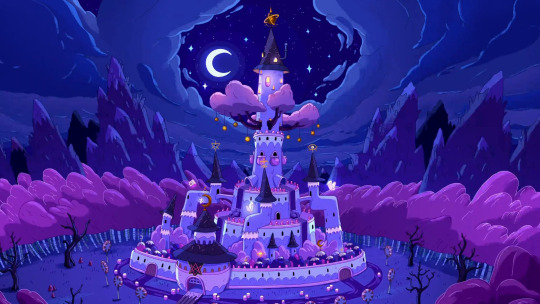
49. Peppermint Butler has a "Boss" mug, although it's not the same colour as the one from "Obsidian".
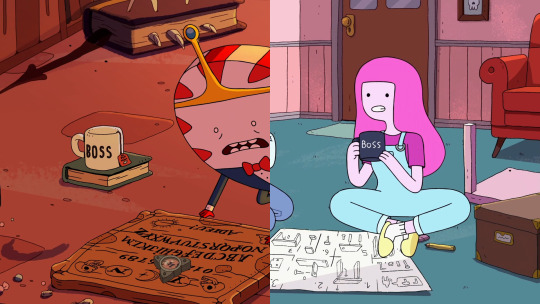
50. Jake's ghost has the same design as he did when BMO killed him in "Ghost Fly". I also absolutely love Finn's ghost. This scene establishes that ghosts are just visitors to the mortal plane from the dead worlds.

51. Life has only appeared in animated shorts before now. Namely, "The Gift That Reaps Giving" which establishes her relationship with Death, and "Frog Seasons: Winter". This episode gives her a concrete place within Adventure Time's pantheon: she is in charge of reincarnation.

52. A translation of Life’s angry French dialogue by Shado: “After all I did for that boy. After all I did for him. No, it's not possible. It's not possible no, that... that makes me so mad but it's not possible.”
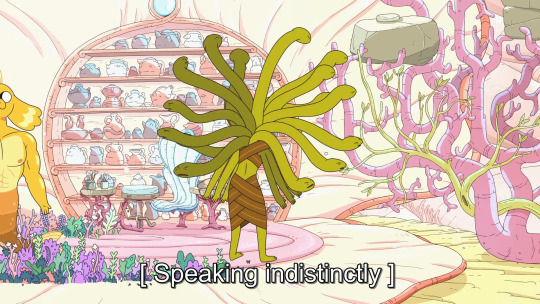
53. We finally have in-universe confirmation that Shoko's tiger is a previous life of Jake. This was previously confirmed by one of the writers, but wasn't canon until now.
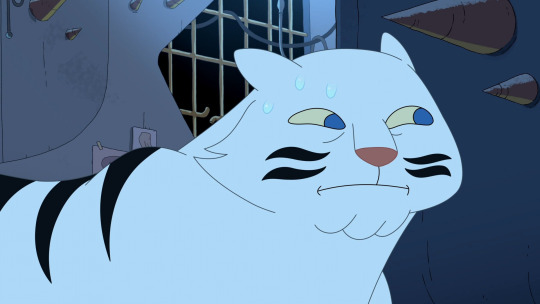
54. I feel like Finn pulled off Shoko's look even better than Shoko did. I wonder whether Finn has gained the memories of his past lives now that he’s dead.

55. No Easter egg here, just want to appreciate this image.

56. There is an elemental symbol on the wall here, as seen in "Jelly Beans Have Power".
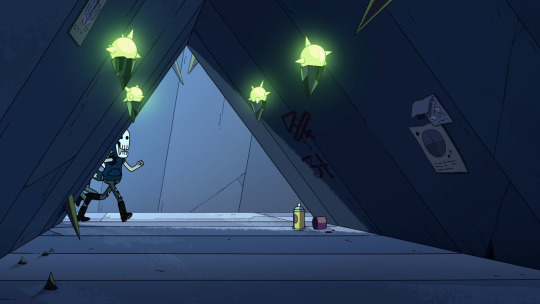
57. Tiffany's dramatic internal monologue is a recurring gag, as is his habit of nearly dying from falling into holes.

58. The Jake suit makes a cameo in the fight against New Death. It was last seen in the episode "Reboot”.

59. Finn's backpack contains a few familiar items: the t-shirt with the pocket from "It Came from the Nightosphere", Finn's underwear from "Little Dude" and other episodes, and a copy of Mind Games as I've already mentioned.

60. The Lich's Hand is present in the background of Death's... death scene. This is probably the unseen "friend" who New Death keeps talking about.
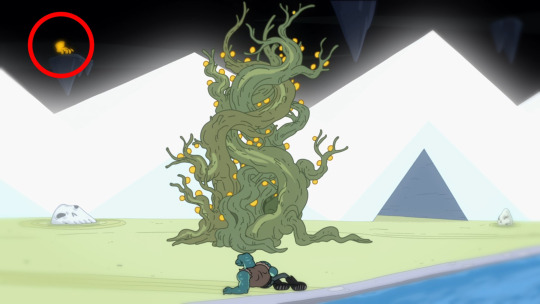
61. The Lich's menacing monologues often begin with a single command. Previously they have included "Fall" and "Stop". This time, the command is "Burn".

62. Jake uses the word "boingloings", which is a callback all the way to "Hitman" in the third season.

63. Jake's blue shape-shifter form from "Abstract" appears very briefly during his fight with Finn.

64. Finn's lumpy space person form also makes an appearance. This design was last seen all the way back in the second episode of the entire show, "Trouble in Lumpy Space".

65. Jake steps on the Lich's hand in a very similar way to how he stepped on Ash in "Memory of a Memory", which is itself a Monty Python reference.
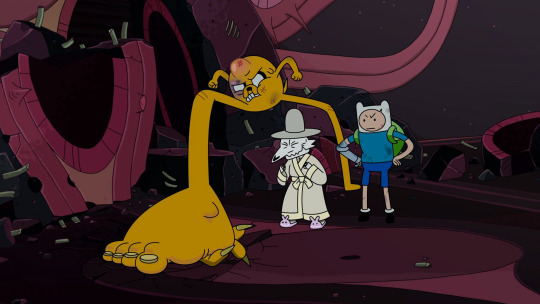
66. The credits include a dedication to a few AT cast and crew who have passed away. Polly Lou Livingston was the voice of Tree Trunks. Miguel Ferrer was the voice of Death. Michel Lyman and Maureen Mlynarczyk were both sheet timers on the original series. Rest in peace.

67. The message that Finn and Jake write out on the ouija board is "BUTT", which Peppermint Butler takes as a distress signal. This message is also used as a distress signal by the Hot Dog Knights in "The Limit".
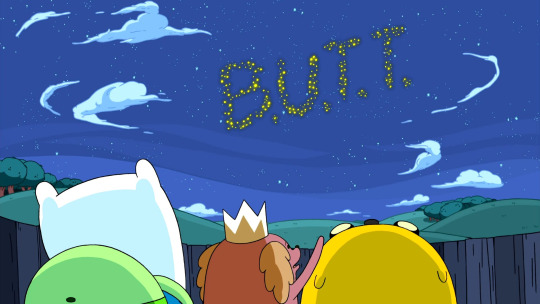
68. Peppermint Butler's reversed dialogue from the scene where he makes contact with Finn and Jake is "Kee-Oth Rama Pancake", the spell from “Dad's Dungeon” for banishing demons.
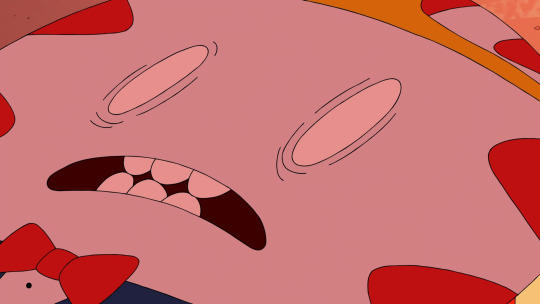
69. That appears to be President Porpoise with all of Tree Trunks’ other lovers.

70. In this scene, Life is humming part of "Lonely Bones", the song which Death tried to record for her in her debut short "The Gift That Reaps Giving". It's hard to notice because it's so brief.
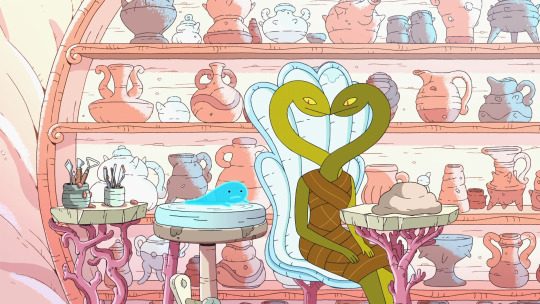
71. Finn and Jake's cover is blown while in the Land of the Dead because Jake loudly farts, which also happened in "Death in Bloom".
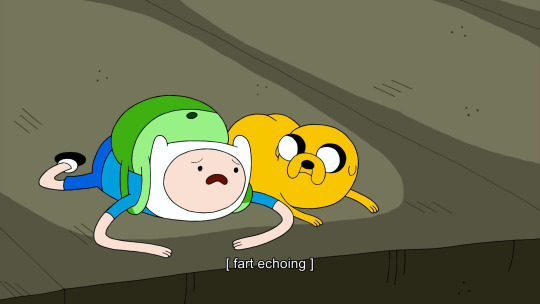
72. The place where Mr. Fox explains the perception mechanics of the afterlife is the exact same location as the River of Forgetfulness from "Death in Bloom", which, as it turns out, was imaginary.

These are sort of out of order at the end because I was adding stuff to the Twitter thread as it got discovered. That’s all for now!
472 notes
·
View notes
Text
R.I.P. (Rest in PDFs), Part I
in progress ...
Part II (N-Z) is here.
Also visit the PDF branch of the Hiroshima Library
Note: If you see your work on here and prefer that it not be made freely accessible, please email me at: [email protected], and I will remove it. Thank you!
+++++++++++++++++++++++++++++++++++++++++++++++++++++++++++
Achille Mbembe, Necropolitics. Translated from the French by Libby Meintjes.
Achille Mbembe, The Power of the Archive and its Limits. Translated from the French by Judith Inggs
Adrienne Rich, Woman and Honor: Some Notes on Lying
Aimé Césaire, Discourse on Colonialism. Translated from the French by Joan Pinkham.
Aimé Césaire, Letter to Maurice Thorez. Translated from the French by Chike Jeffers.
Aimé Césaire, Notebook of a Return to the Native Land. Translated from the French by Clayton Eshleman and Annette Smith
Alexis Pauline Gumbs, the introduction to M Archive: After the End of the World
Alex S. Vitale, The End of Policing
All Monuments Must Fall: A Syllabus, created/crowd-sourced by Nicholas Mirzoeff and many others
Amilcar Cabral, Return to the Source: Selected Speeches
Amy Uyematsu, The Emergence of Yellow Power
Andaiye, Counting Women’s Caring Work: an interview with David Scott
Angela Davis, Abolition Democracy: Beyond Empire, Prisons, and Torture
Angela Davis, Are Prisons Obsolete?
Angela Davis, Racialized Punishment and Prison Abolition
Angela Davis, Women, Race, Class
Angel Dominguez, Black Lavender Milk
Angie Morrill, Eve Tuck, and the Super Futures Haunt Qollective, Before Dispossession, or Surviving It
Anne Anlin Cheng, The Melancholy of Race
Anne Anlin Cheng, Ornamentalism: A Feminist Theory for the Yellow Woman
Anne Boyer, No, from A Handbook of Disappointed Fate
Antonio Gramsci, The Gramsci Reader: Selected Writings 1916-1935
Asian American Feminist Antibodies {care in the time of coronavirus}, a zine by Asian American Feminist Collective, in collaboration with Bluestockings NYC,
Assata Shakur, Assata: An Autobiography
Audra Simpson, On Ethnographic Refusal: Indigeneity, ‘Voice’ and Colonial Citizenship
Audre Lorde, I Am Your Sister: Black Women Organizing Across Sexualities
Audre Lorde, Poetry is Not a Luxury
Audre Lorde, The Transformation of Silence into Language and Action
Audre Lorde, The Uses of Anger
Aufgabe, Number 4, Fall 2004, feat. Japanese poetry in translation guest edited by Sawako Nakayasu
Aufgabe, Number 13, 2014, feat. poetry in translation from India guest edited by Biswamit Dwibedy & a special section of poetry from the Moroccan journal Souffles
Bayard Rustin, “Black Power” and Coalition Politics
bell hooks, all about love: New Visions
bell hooks, Black Looks: Race and Representation
bell hooks, Feminism Is For Everybody: Passionate Politics
bell hooks, Feminist Theory from margin to center
bell hooks, Teaching to Transgress: Education as the Practice of Freedom
Benedict Anderson, Imagined Communities: Reflections on the Origin and Spread of Nationalism
Bhanu Kapil, Reading Lauren Berlant in the Bath
C.L.R. James, The Black Jacobins: Toussaint L’Ouverture and the San Domingo Revolution
Calvin Warren, Black Care
Calvin Warren, the introduction to Ontological Terror: Blackness, Nihilism, and Emancipation
Carrie Lorig, The Book of Repulsive Women: Five Increasing / Rhythms
Cathlin Goulding, Walking the Places of Exception: The Tule Lake National Monument
Cathy Caruth, Unclaimed Experience: Trauma, Narrative, and History
Cedric Robinson, Black Marxism: The Making of the Black Radical Tradition
Chandra Talpade Mohanty, Under Western Eyes: Feminist Scholarship and Colonial Discourses
Chela Sandoval, Methodology of the Oppressed
Christina Sharpe, Kara Walker’s Monstrous Intimacies (from Monstrous Intimacies: Making Post-Slavery Subjects)
Christina Sharpe, The Wake (the first chapter of In the Wake: On Blackness and Being).
Claudia Jones, An End to the Neglect of the Problems of the Negro Woman
David J. Getsy and Che Gossett, A Syllabus on Transgender and Nonbinary Methods for Art and Art History
David L. Eng, The Value of Silence
Denise Ferreira da Silva, On Difference Without Separability
Denise Ferreira da Silva, Toward a Black Feminist Poethics
Denise Ferreira da Silva, Toward a Global Idea of Race
Diana Taylor, The Archive and the Repertoire: Performing Cultural Memory in the Americas
Diane di Prima, Revolutionary Letters
Dionne Brand, An Ars Poetica from the Blue Clerk
Divya Victor, Ten Little Poets
Divya Victor, from Things To Do With Your Mouth
Dot Devota, T H E D O G W O O D S
dusie 19: The Asian Anglophone issue (edited by Cynthia Arrieu-King)
Édouard Glissant, Caribbean Discourse: Selected Essays. Translated from the French by J. Michael Dash.
Eduardo Galeano, Open Veins of Latin America: Five Centuries of the Pillage of a Continent. Translated from the Spanish by Cedric Belfrage
Edward Said, Culture and Imperialism
Edward Said, Orientalism
Edward Said, Out of Place: A Memoir
Edward Said, Permission to Narrate
Edward Said, Reflections on Exile: & Other Literary and Cultural Essays
Elizabeth Castle, "The Original Gangster": The Life and Times of Red Power Activist Madonna Thunder Hawk
Elizabeth Grosz, Time Travels: Feminism, Nature, Power
Ellen Wu, Imperatives of Asian American Citizenship (intro to The Color of Success: Asian Americans and the Origins of the Model Minority)
Epeli Hau’ofa, Our Sea of Islands
Eqbal Ahmad, Reader: Writings on India, Pakistan and Kashmir, ed. Sarthak Tomar
Eric A. Stanley and Nat Smith, editors, Captive Genders: Trans Embodiment and the Prison Industrial Complex
Errico Malatesta, The Anarchist Revolution: Polemical Articles 1924-1931
Etel Adnan, At Two in the Afternoon. Translated from the French by Sarah Riggs.
Etel Adnan, all the questions in Sitt Marie Rose. From Georgina Kleege’s translation from the original French.
Etel Adnan, Sitt Marie Rose. Translated from the French by Georgina Kleege.
Etel Adnan, To Be In A Time Of War
Eunsong Kim, Appraising Newness: Whiteness, Neoliberalism, and the Building of the Archive for New Poetry
Eunsong Kim, Copy Paper: Ream 1
Eunsong Kim, Dear Machines
Eunsong Kim, Found, Found, Found: Lived, Lived, Lived
Evelyn Nakano Glenn, Unequal Freedom: How Race and Gender Shaped American Citizenship and Labor
Eve Tuck and K. Wayne Yang, R-Words: Refusing Research
Eve Tuck and K. Wayne Yang, What Justice Wants
Fay Chiang, excerpts from 7 Continents, 9 Lives
Fayez A. Sayegh, Zionist Colonialism in Palestine
Frank B. Wilderson III, The Prison Slave As Hegemony’s (Silent) Scandal
Frank B. Wilderson III, Sideways Between Stories
Frantz Fanon, Black Skin, White Masks. Translated from the French by Charles Lam Markmann.
Frantz Fanon, A Dying Colonialism. Translated from the French by Haakon Chevalier
Frantz Fanon, Toward the African Revolution. Translated from the French by Haakon Chevalier.
Frantz Fanon, The Wretched of the Earth. Translated from the French by Richard Philcox.
Frederick Engels, Socialism: Utopian and Scientific
Fred Moten, Blackness and Nothingness (Mysticism in the Flesh)
Fred Moten, from Day
Fred Moten, In The Break: The Aesthetics of the Black Radical Tradition
“from the river to the sea”: Collection of Palestine Solidarity Zines
Gary Okihiro, Is Yellow Black or White?
Gayatri Chakravorty Spivak, Can the Subaltern Speak?
Gelare Khoshgozaran, Airgrams
George Jackson, Blood In My Eye
George Jackson, Soledad Brother: The Prison Letters
Georges Bataille, The Absence of Myth: Writings on Surrealism. Translated from the French by Michael Richardson.
Georges Bataille, The Bataille Reader
Georges Bataille, Blue of Noon. Translated from the French by Harry Mathews
Georges Bataille, Inner Experience
Ghassan Kanafani, The 1936-39 Revolt in Palestine.
Ghassan Kanafani, The Stolen Shirt. Translated from the Arabic by Michael Fares
Ginger Ko, Ghosts, Models, Visions
Glen Coulthard, Red Skin White Masks: Rejecting the Colonial Politics of Recognition
Gloria Anzaldúa, How to Tame a Wild Tongue
Grace Lee Boggs, Living for Change: An Autobiography
Grace Lee Boggs, Reimagine Everything
Indefensible: A Decade of Mass Incarceration of Migrants Prosecuted for Crossing the Border. By Judith A. Greene, Bethany Carson, Andrea Black, for Grassroots Leadership and Justice Strategies (2016).
Haunani-Kay Trask, The Color of Violence
Hiromi Itō, The Thorn-Puller: New Tales of the Jizō Statue at Sugamo. Translated from the Japanese by Jeffrey Angles.
Hortense Spillers, All the Things You Could be by Now, If Sigmund Freud's Wife Was Your Mother: Psychoanalysis and Race
Huey P. Newton, Revolutionary Suicide
The Huey P. Newton Reader. Edited by David Hilliard and Donald Weise
Ibrahim Nasrallah, Gaza Weddings. Translated from the Arabic by Nancy Roberts
Ibrahim Nasrallah, Time of White Horses. Translated from the Arabic by Nancy Roberts
Immigration and Nationality Act, June 27, 1952. See especially SEC. 212: General Classes of Aliens Ineligible to Receive Visas and Excluded from Admission
#ImmigrationSyllabus. Created by immigration historians affiliated with the Immigration History Research Center and the Immigration and Ethnic History Society, January 26, 2017
Interviews with Radical Palestinian Women, compiled by the Shoal Collective, 2018-2021
J. Sakai, Settlers: The Mythology of the White Proletariat
Jackie Wang, Against Innocence: Race, Gender, & The Politics of Safety
Jackie Wang, On Being Hard Femme
Jackie Wang, Policing as Plunder: Notes on Municipal Finance and the Political Economy of Fees and Fines, from Carceral Capitalism
Jacques Derrida, The Work of Mourning
Jacques Derrida, Writing and Difference. Translated from the French by Alan Bass
Jalal Toufic, Undeserving Lebanon
Jalal Toufic, The Withdrawal of Tradition Past a Surpassing Disaster
James Baldwin, The Fire Next Time
James Baldwin, Notes of a Native Son (essay)
James Baldwin, Nothing Personal
James Boggs, Pages From a Black Radical’s Notebook
Jean-Claude Michel, The Black Surrealists
Jean Genet, Four Hours in Shatila
Jennifer C. Nash, Feeling Black Feminism, the introduction to Black Feminism Reimagined: After Intersectionality
Jennifer Kwon Dobbs, Notes from a Missing Person
Jennifer Tamayo, Poems are the Only Real Bodies
Jenny Zhang, Hags
John Berger, Ways of Seeing
John Gregory Dunne, Delano: The Story of the California Grape Strike
Jose Ortega y Gasset, The Revolt of the Masses
Joy James, The Dead Zone: Stumbling at the Crossroads of Party Politics, Genocide, and Postracial Racism
Julia Kristeva, Powers of Horror: An Essay on Abjection
Julietta Singh, No Archive Will Restore You
Julietta Singh, the introduction to Unthinking Mastery: Dehumanism and Decolonial Entanglements
Kamau Brathwaite, History of the Voice (from Roots)
Kamau Brathwaite, Nation Language
Karen Tei Yamashita, Literature as Community: The Turtle, Imagination & the Journey Home
Katherine McKittrick, the acknowledgments of and introduction to Dear Science and Other Stories
Katherine McKittrick, Demonic Grounds: Black Women and the Cartographies of Struggle
Kathi Weeks, The Problem with Work: Feminism, Marxism, Antiwork Politics, and Postwork Imaginaries
Keeanga-Yamahtta Taylor, Chapter 7 of From #BlackLivesMatter to Black Liberation
Keguro Macharia, Queering African Studies
The Kojiki: Record of Ancient Matters. Translated from the Japanese by Basil Hall Chamberlain
Kwame Nkrumah, Neo-Colonialism: The Last Stage of Imperialism
Lara Mimosa Montes, from The Somnambulist
Leila Khaled, My People Shall Live: Autobiography of a Revolutionary, as told to George Hajjar
Linda Tuhiwai Smith, Eve Tuck, and K. Wayne Yang, Indigenous and Decolonizing Studies in Education
Lisa Lowe, History Hesitant
Lisa Lowe, Immigration, Citizenship, Racialization: Asian American Critique (from Immigrant Acts)
Lisa Lowe, The Intimacies of Four Continents
Loss: The Politics of Mourning. (eds. David L. Eng & David Kazanjian)
Lynn Xu, Say You Will Die For Me
Lynn Xu, Tournesol
Mae Ngai, From Colonial Subject to Undesirable Alien: Filipino Migration, Exclusion, and Repatriation, 1920-1940
Mae Ngai, Illegal Aliens: A Problem of Law and History (intro to Impossible Subjects: Illegal Aliens and the Making of Modern America)
Mahmoud Darwish, If I Were Another, translated from the Arabic by Fady Joudah
Mahmoud Darwish, Unfortunately, It Was Paradise: Selected Poems, edited and translated from the Arabic by Munir Akash and Carolyn Forche (with Sinan Antoon and Amira El-Zein)
Malcolm X Speaks: Selected Speeches and Statements
Manifesto: A Century of Isms, edited by Mary Ann Caws
The Manyōshū, the Nippon Gakujutsu Shinkokai translatton
Mariame Kaba, Toward the Horizon of Abolition: John Duda in conversation with Kaba
Marianne Hirsch, The Generation of Postmemory
Marianne Hirsch and Nancy K. Miller, the introduction to Rites of Return: Diaspora Poetics and the Politics of Memory
Mari Matsuda, Planet Asian America
Mari Matsuda, Public Response to Racist Speech: Considering the Victim's Story
Mark Rifkin, Beyond Settler Time: Temporal Sovereignty and Indigenous Self-Determination
Mercedes Eng, Mercenary English
Merle Woo, Stonewall Was a Riot—Now We Need a Revolution
Michael Hardt and Antonio Negri, Empire
Michel Foucault, The Care of the Self (Volume 3 of The History of Sexuality). Translated from the French by Robert Hurley
Michel Foucault, Discourse and Truth: The Problematization of Parrhesia
Michel-Rolph Trouillot, The Otherwise Modern: Caribbean Lessons from the Savage Slot
Michel-Rolph Trouillot, The Power in the Story
Michel-Rolph Trouillot, An Unthinkable History: The Haiti Revolution as a Non-Event
Mimi Thi Nguyen, The Empire of Freedom (the introduction to The Gift of Freedom: War, Debt, and Other Refugee Passages)
Mishuana Goeman, Gendered Geographies and Narrative Markings; “Remember What You Are”: Gendering Citizenship, the Indian Act, and (Re)mapping the Settler Nation-State, from Mark My Words: Native Women Mapping Our Nations
Mitsuye Yamada, Invisibility is an Unnatural Disaster: Reflections of an Asian American Woman
Mizna 19.2: The Palestine Issue, 2018
M. Jacqui Alexander, Remembering This Bridge Called My Back, Remembering Ourselves
Mu'in Basisu, Palestinian Notes from Cairo's Military Prison, translated from the Arabic by Saleh Omar
+++++++++++++++++++++++++++++++++++++++++++++++++++++++++++
Part II (N-Z) is here.
The PDF branch of the Hiroshima Library is here.
568 notes
·
View notes
Text
week 9 lecture the end of the future
Week 9 lecture was about the what came after the utopian idealism of modernism.
Future was invented by the futurists and finished by 1970’s Punk Rock movement.
When I think about ‘punk style’, it reminds me of something very off the limit and free. Punk movement was the liberation from modernist pop. It influenced counter-cultural movements that were designed and distributed and the communication was hijacked by this movement.

source: https://www.telegraph.co.uk/music/artists/god-save-queen-40-sex-pistols-made-controversial-song-history/
This poster by a British punk rock group ‘Sex Pistols’ has portrait of the queen been collaged with types and approached black mail notice from a kidnapper. There is almost violent attack, looking even inappropriate and disrespectful. It has notion of French situationnist distorting cultural artifact.
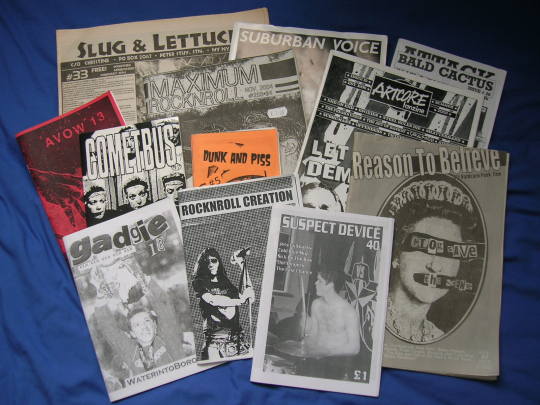
source: https://en.wikipedia.org/wiki/Punk_zine#/media/File:UK_and_US_zines.jpg
These are the punk zines from 1970s. They don’t respect the aesthetic built from previous art movements, they ignore the traditional composition, harmony or typography, and approached completely refreshing design. It looks kind of rebellious to me. A lot of them have collage-like aesthetic.
Punk movement was breaking away from 'metanarratives' modernism has established. It was also responding to the culture of the time which was struggling in a moment where the government was taking a lot of money from poor people and there was lot of unemployment. It was a reaction to give identity to people.
Andy introduced another type of Punk from Milan and Northern American, the group ‘Memphis’.

source: Ettore Sottsass, bookshelf, 1980, https://www.creativebloq.com/inspiration/10-iconic-examples-of-memphis-design
The aesthetic of Memphis group is very different from the previous punk design. Opposing to modernism authenticity, the book shelf can’t tell what materials there are. All materials are laminated and the surface, pattern and playfulness takes more places than the materials. it is a wide range of bizarre creation, which connects with the approach of Punk.

source: couch, 1984, https://wearethemutants.com/2018/09/20/no-powerful-idea-lasts-long-the-memphis-group-and-the-1980s-look/
source: lamp,1984, https://www.shlomitofir.com/inspired-by-memphis/
source: chair, 1984, https://wearethemutants.com/2018/09/20/no-powerful-idea-lasts-long-the-memphis-group-and-the-1980s-look/80s-aesthetics-memphis-3-2/
These are the zine covers from Memphis from 1984. They look completely different from the 70s punk zines, these have more design considerate composition, illustration and vivid colours. They look more simple and modern and less rejecting the traditional aesthetic. The furnitures of Memphis is like collage of geometric shapes rather than sublime sketched shapes.
youtube
This video is an intro of an American TV episode ‘Saved By The Bell’ in 1989. It approached the Memphis style with strong vivid colours, crazy pattern and shapes flying everywhere. But I personally don’t like how they just threw everything which looks just childish, whilst the Memphis' designs reflect more consideration.
Nathalie Du Pasquier, an artist from Memphis group said
“most people think about Memphis, that it was just fun. But bright colors are not childish. Those patterns were not funny. It was totally misunderstood in the sense that it was taken for a joke – that the serious thinking was part of Modernism, and because what we were doing was in reaction against that, it meant we were not serious, in the sense that we thought they were important, and we deeply felt them.”
(‘Surface Matters’, Metropolis, April 2015)


source: Saved by the Max pop-up restaurant, Chicago, https://www.curbed.com/2017/6/23/15864234/furniture-memphis-design-ettore-sottsass
source: New York magazine, 1982, https://www.curbed.com/2017/6/23/15864234/furniture-memphis-design-ettore-sottsass
These are also Memphis inspired works. They look so playful and the space makes you happy from just being there. The colour palette of the first photo somehow reminds me of The Simpsons’ vivid look. I believe Memphis’ punk style is timeless because it has been more than 30 years since the movement ended but Memphis is maintaining the style and still being loved.
Both style of punk movement intended to inspire and give identity to people but the they took a different directionand the outcomes were also very different. It only lasted for about a decade but it changed the aspects of design and opened the limitation of expression.
2 notes
·
View notes
Photo


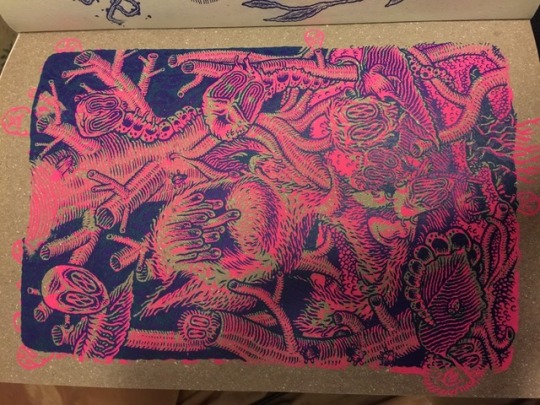
Hi! First, my usual prefaced apology for the reviews coming few and far between. I'm busy, insanely busy, and I have a years worth of mini comics to get through. Probably from here on out everything I review is long out of print and unavailable, that's how behind I am. But I'm gonna soldier on, all for that sweet satisfaction of getting a random 'like' from Ed Piskor or Nick Gazin. Well, mild satisfaction. Now, Dick Debartolo, getting a 'like' from him will make me jack off for a week! This book is from Ediciones Joc Doc and the artist is Craoman and its called 'Agarrarla'. I don't speak French or Spanish in the slightest so I don't' have much to offer in terms of back story here. The artist is French, the publisher is Spanish. The book is god damn rare golden syrup style GOOD. These comics, from something like 5 years ago, are an insane mix of Marc Bell, Dave Cooper, and Mark Beyer style gooshie-ness. The dude flat out has a very 'Mojo Action Companion Unit' (how many of ya young kids were around to buy that mini?) strip with the author portrayed in Marc Bell style hunch with backpack, skinny jeans, and knit cap 'artist-as-rambler' style shit. I assume the tale is about the artist but am not for sure as it was in Spanish and, as said before, I don't know Spanish. The rest of the book is filled with solid and earnest gross out stuff to the max. But not banal and simple Jonny Ryan style gross out shit, this is lovingly sculpted and studied gross out shit that comes straight from the CORE. Craoman is the drawing master and creates a world of big headed baby boys and teddy bear girls that get together for all sorts of insanity that result in such lines being said as " Oh Lord... but... he's having a shit... he's having a SHIT through his DICK!!" Yeah, that kinda gold. This stuff is the stuff that occupies that place beyond rational explanation or comparison because there is just no point of reference on this green earth for this kinda shit. Its kinda like staring at the suns' corona, I can't properly explain it ya just needed to be there. And the book itself, the packaging, is just phenomenal. Rough paper that has these little sparkly bits of foil like material in it, ink that is all lumpy and sitting on the page, and these beautiful neon colored inserts on cardboard that just must be seen to be believed. This is a real art book, a comic book, a gross out book; this is the awesome book. If you can't read shit like this you're a fucking wimp, put down the social justice zine and read some real art about filling tin cans with corpses' shit and marketing it as seaweed soup to stupid punx (another line pulled from the book). Get this fucker now, do a search for the names and you'll find it. #jocdoc #craoman #screenprint #comix #minicomic
5 notes
·
View notes
Photo



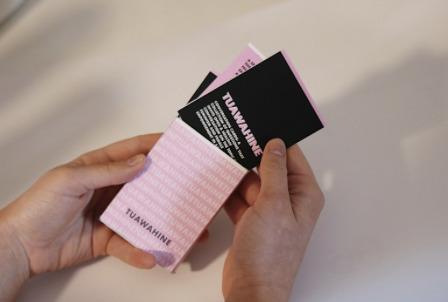

Feminism and the empowerment of women in Aotearoa
As a group we have decided to research and create a learning tool that educates the role of women in Aotearoa and how feminism has played a part in that.
Learning tool ideas:
Board game
Zine/pamphlet
Playing cards/conversation cards
Memory game
Educational phone app
RESEARCH
Women in Maori Culture - pre colonisation of NZ
Gender equality within maori culture beings even in the language. Personal and possessive pronouns are gender neutral. (Tana/tona)
The empowerment of women is written into proverbs. Rose Pere writes how women are the ‘whare tangata’, the house of humanity.
“He wahine, he whenua, e ngaro ai te tangata” : “by women and land men are lost”. Refers to the essential nourishing roles that women and land fulfil. Without these things humanity would be lost.
In pre-colonial times Maori women used to retain their own names upon marriage.
Conception was not associated with sin rather it was uplifted and a normal part of life.
If anyone was abusive to women, they would be punished seriously - sometimes by death - but otherwise would be declared “dead” to the community and ignored
The parents were not sole caregivers of the children, grandparents and extended family often were heavily involved in the raining of each others children so women could also have other responsibilities and leadership roles.
Maori is an oral culture and the waiata tawhito were often composed by women.
The status of women under the english law: the father/husband was the head of the family and the wife and children “were chattels to be used and abused by paterfamilias as he chose.” As girls grew up to be married, they shifted from the poverty of their fathers to the husband. Any property they brought with them to the marriage was vested to the husband for hum to do what he liked with it. The wife has no legal rights her kids, even if divorced no matter the circumstances.
When europeans arrived on aotearoa shores, the europeans did not want any of the women to have power. All maori myths and legends had to be reshaped to empower men not women. Through these processes maori women found their mana wahine to be destroyed.
Linda Smith writes “Maori women were perceived either in family terms as wives and children, or in sexual terms as easy partners. Women who had “chiefly” roles were considered the exception to the rule...not the norm. Maori women were considered attractive in the absence of a pool of white women. Their autonomy was interpreted as immorality and lack of discipline. Christianity reinforced these notions by spelling out rules of decorum and defining spaces (the home) for carrying out appropriate female activities.”
Maori women were considered as potential sources of land and economic security. As well as used for wives and children, and bedmates for white men.
The concept of having women as leaders was incomprehensible for the settlers, which is why barely any women signed the treaty.
Further research on feminist movements in nz.
Until the 60’s women's roles were strictly in the house and a men's place was in the workplace. Women had been ‘man powered’ during world war 2 but after returned to running the household and raising kids.
The contraceptive pill was actually a big thing to be established in the early 60’s as it allowed women to be free to have sex with men more for recreation instead of for child bearing intentions. This triggered questions of women and their status in society and they started to enter the workforce and higher education. They entered and seek jobs not traditionally associated with women.
The women’s liberation movement came to be in the 70’s where they challenged the belief that a woman's place was in the home. They began to demand equal rights with men. Maori feminists also tackled racism and land issues.
“Girls can do anything” was the slogan of the 80’s.
By the end of the 20th century, women held many powerful positions, including that of Prime Minister. For many women, the new struggle was balancing the roles of mother and wage earner.
http://sites.tepapa.govt.nz/sliceofheaven/web/html/feministmovement.html
Jenny Shipley was the first female PM in 1997.
Helen clark was the second female PM who came into the position in 1999. She ran in office for 9 years.
Jacinda Adern is the 3rd female PM and is the current PM in nz
Kate Sheppard led the women's suffrage movement in NZ.
In 1893 she gathered 32,000 signatures to support their cause. A 270 m petition - the longest to ever be presented to parliament. That year it was passed by both houses and became law on september 19.
Nz was the first self governing nation in which women had the right to vote!! Other democracies like britain and U.S did not give women the right to vote until after ww1.
Women did not gain the right to stand in parliament until 1919 and the first female MP was not elected until 1933.
Elizabeth Mccombs was nz first elected mp in 1933.
https://nzhistory.govt.nz/womens-suffrage-day
Feminism: the advocacy of women's rights on the ground of the equality of the sexes.
“Their identities as Maori and as women share aspects of each other, and both identities at times join in opposition to white male-dominated culture. In particular maori activist women work to redefine and recreate their cultural tradition, rejecting certain aspects of pakeha culture and the imposition of Western aspects of ethnicity.” - Michele D. Dominy: Pg 11
“Only “activist” Maori women redefine and recreate their cultural tradition. In this, activist Maori women take their cue from the feminist struggle and reinvent tradition, as do their pakeha counterparts” pg 12 https://www.jstor.org/stable/4316423?seq=11#metadata_info_tab_contents
"I'm hard out a feminist. But the discussion on Māori feminism on @TheHuiNZ I also totally agree with because the way feminism gets used and described makes it about supporting the patriarchy with a bit of pay equity," Gabrielle Baker
“The Māori Renaissance was a social movement of the 1970s which served to revive te reo Māori (the Māori language) and tikanga Māori (cultural practices). For many Māori women though, there was an underlying tension between the politics, culture and language of Māori society that the Māori Renaissance was struggling to preserve and the barriers in Māori society that had prevented Māori women from participating in, and contributing to, Māori society. This paper examines the importance of de-storying narratives of mono-culturalism within the context of postcolonial Aotearoa/New Zealand in order to create space for biculturalism and distinct Māori feminist frameworks such as Mana wāhine Māori, a Māori feminist discourse which affirms Māori women as critical actors for social change.” https://researchspace.auckland.ac.nz/handle/2292/33546 : Maori women overlooked and not approached for valuable and crucial decisions within the maori culture and community.
Moari renaissance: https://teara.govt.nz/en/maori-pakeha-relations/page-6
We have decided to create a set of conversation cards that can be used for social or educational purposes. These will be focused on creating a space for people to discuss their ideas about feminism in New Zealand in a safe, open way. We will look to include factual information as well as open ended questions that can hopefully result in informative, interesting conversation.
History of Playing Cards
A deck of cards are familiar to new zealand households and people all around the world. The deck is made up of 52 cards ranging from kings, queens, jacks, aces, jokers, suits and number cards. With such a large variety of cards there are many games and uses that have become known over the years.
Playing cards were first invented by the chinese before AD1000. Next around 1360 the cards soon spread into Europe, India and persia. Egypt was next to experience the card during the time of Mamluk control in the 14th century, which is why european playing cards have hints of islamic derivation.
When playing cards were first invented they were hand painted, and considered works of art that only wealthy individuals such as dukes and emperors could afford. Now in today's age playing cards generally look the same and can be found just about anywhere.
Almost every card in a deck of playing cards it made from a suit, the history of these suits is an interesting interplay between words, shapes and concepts. The suits used with muslim mameluke suits were origonally made from goblets, gold coins, swords and polosticks. Then once the cards moved to europe the polostick was turned into batons or slaves, which are now traditional suits for the italian and spanish along with suits of swords, cups and coins.
In the fifteenth century, german card makers experimented in suits similar to italian and spanish but instead used acorns, leaves, hearts and bells for suits. By the time of 1480 playing cards became in high demand and popular, therefore the french began producing large quantities of playing cards through stencil. To make the stenciling process easier the french simplified the suits by turning them into clovers (clubs) , hearts, Pike heads (spades) paving tiles (diamonds) over time people have become familiar with these shapes and renamed them to more simplistic names for example “paving tiles” are now called “diamonds”.
https://www.theguardian.com/notesandqueries/query/0,5753,-2647,00.html
https://www.wopc.co.uk/history/1
Our group project is based on moari feminism therefore it significantly impacts our topic. Our initial idea is to create a conversation starter deck of cards, based on facts or questions relating to moari feminism. The definition of feminism is “the advocacy of women's rights on the ground of the equality of the sexes.” therefore gender is going to be a standing factor in our research and project itself. Sextually may be a contributing factor within our research and project however wont impact the project as significantly as gender.
Artists:
Sandra coney born in auckland and is very knowledgeable about feminism within new zealand. “Sandra Coney QSO is a women’s health campaigner, historian, feminist and local body politician. She was a founder and long-term editor of Broadsheet magazine, and is the author and/or editor of over 20 books.” ("Writer: Sandra Coney - Writers • Auckland Writers Festival", 2019)
References:
An Unfortunate Experiment at National Women's. (2019). Retrieved 19 September 2019, https://www.metromag.co.nz/society/society-etc/an-unfortunate-experiment-at-national-womens
Writer: Sandra Coney - Writers • Auckland Writers Festival. (2019). Retrieved 19 September 2019, from http://www.writersfestival.co.nz/programmes/writers/sandra-coney
Both men and women were essential parts of the collective whole, of the natural order of the universe. Both formed part of the whakapapa that linked Moari back to the beginning of the world, and women played a key role in linking the past with the present future.
Both parties allowed for the survival, therefore both women and men were valued and protected.
No hierarchy of the sexes between maori language, instead personal pronouns are used and are gender neutral
Words within the moari language have different meanings e.g hupu means pregnant and large kingship.
Childhood was full of positive female roles
Assault on women could result in death
With marriage the transfer of property etc was still womens
Grandmothers, aunts, other females and males elders were responsible of taking care of children, therefore allowing to perform a wide range of roles including leadership roles.
From histories handed down moari women had many leadership positions in traditional society such as military, spiritual and political significance
The status of women under english law
Head of the family (husband/father) was in control of the household.
As girls reached adulthood they changed from being property of their fathers to being property of their husbands.
Property that a woman brought to the marriage was immediately the husbands.
No legal personality at all
Once married the male retained is independent service while a woman has demand “in service”
Until 1985 Rape could not be perpetranted in New Zealand Law by a husband against is wife as his wife was the husbands property
How this impacted moari women when the colonization law was introduced.
Western civilisation when arriving in new zealand did not allow women any power.
Re telling of Moari cosmology led to a shift in emphasis, away from powerful female influences and towards male characters.
Moari women were perceived in family terms as wives and children or in sexually terms as easy partners.(the property of maori men)
Moari women were perceived as attractive in a pool of white women (potential bed mates for white men.
Women with chifley roles were considered the exception, not the norm…
The concept of women as leaders and spokesperson of there whanau, hupi and iwi were destroyed.
Because the treaty of waitangi was only signed predominantly by men this shows the pre-colonisation moari society's attitudes towards women.
Moari women when married has to be subservient, lacking in initiative and obedient to her husband.
Moari men became the breadwinners while women became isolated as caregivers in their homes
Schools began to train moari girls how to become good house wives
Schools were discouraged from becoming to academically oriented with the aim for moari education to allow moari men to be good farmers and maori women to be farmers wifes. They were being taught manual labor and also the correct lifestyle deemed with european culture.
A large portion of maori women could not find jobs with pakeha house holds
What card games already exist in the feminism field
https://www.bookdepository.com/Little-Feminist-Playing-Cards-Lydia-Ortiz
Little feminist playing cards - Standard set of playing cards that have images of women who have had important roles in history. Targeted towards younger children to introduce them to these important female figures.
https://www.bookdepository.com/Wonder-Women-A-Happy-Families-Card-Game
Wonder Women, a happy families card game – based on the card game happy families although the cards are illustrated with inspiring women the aim is to see who knows the most about these women
https://www.bookdepository.com/Feminist-Flashcards-Julie-Merberg/
Feminist Flashcards – young readers and activists can learn about famous women’s’ history and different facts, the cards can be used for a number of different uses
There are only a few feminism based card games that are currently being produced, although the majority of them are either targeted towards children or are produced and sold overseas. At the moment there are no card games that exist that are specifically based around our idea of Maori feminism/feminism in New Zealand therefore there is a gap in the market for our ‘product’.
Context of the playing cards
Our playing cards would be used predominantly as a dinner table game or for educational purposes. The idea of our cards is to spark conversation about feminism, and in particular in Maori culture as this isn’t a topic that is widely discussed. Our cards would include open ended questions to help spread awareness. They could also be used as a teaching facility in schools. Although feminism is quite a widely discussed topic, it always seems to be in general rather than in certain cultures.
Dictionary Definition of Feminism: “the advocacy of women's rights on the ground of the equality of the sexes.”
“Feminism is a social movement and ideology that fights for the political, economic and social rights for women. Feminists believe that men and women are equal, and women deserve the same rights as men in society. The feminist movement has fought for many different causes, such as the right for women to vote, the right to work and the right to live free from violence.”
https://rosie.org.au/our-world/womens-rights/what-is-feminism/
Different ways we can make the cards:
Playing cards
Conversation cards
Education cards
Study cards
Online/Digital learning cards
Role Play cards
We are planning to have three different categories of conversation starter: Did you know, what do you think and true or false. We hope that through this we can create different types of conversation in a fun way. We do have concerns about the true or false as we dont want to offend or mislead anyone, so will be cautious about what we say.
Did you know?
Did you know that on the 19th September 1893 the government of New Zealand passed the law for women to have the right to vote. This meant New Zealand became the first self governing country in the world in which all women had the right to vote in elections.
Did you know that in the Maori language, personal and possessive pronouns are gender neutral.
Did you know that the Maori culture ensures the empowerment of women is written into their language with phrases such as “He wahine, he whenua, e ngaro ai te tangata”. This means “by women and land men are lost,''referring to the essential role that women fulfil, and without them humanity would be lost.
Did you know that, even after the progress women have made in gender equality, they still continue to be paid significantly less than men, are more likely to be unemployed or in unpaid work, and experience high rates of violence and abuse.
Did you know “Girls can do anything” was the slogan of the 80’s.
Did you know that when the contraceptive pill was introduced in 1961, this further allowed women to have rights over their own bodies and separated them from just being of child bearing intentions.
True or False?
True: Nz was the first self governing nation in which women had the right to vote.
True: In 1997 Jenny Shipley became the first woman Prime Minister of New Zealand.
True: Early European settlers in New Zealand generally thought that the Māori women did not have power and only negotiated with men.
False: New zealand has had 40 prime ministers with only 4 being women.
True: In the 19th century women were excluded from many occupations such as Banks, businesses, post and telegraph offices, teaching and nursing, and the professions and trades.
False: In the early 20th century women's Wages were equal to those of men doing the same or similar work.
False: By 1966 women made up 40% of the paid workforce.
What do you think?
1. What do you think the Maori women felt after the colonisation of New Zealand?
2. What do you think encouraged the women of New Zealand to protest the right to vote?
3. What do you think about the current position of women in New Zealand?
4. What do you think about the stereotypes of gender roles being challenged?
5. What do you think about the debate of abortion laws in the 1970’s?
6. What do you think about women’s rights?
7. What do you think your standpoint is in the ongoing right for equality? Do you support it?
8. What do you think could be done differently to help support the women of New Zealand?
9. What do you think you know about the history of Maori feminism?
10. What do you think about New Zealand being the first country to allow women to vote?
11. What do you think about only three of the forty prime ministers New Zealand has had being female?
12. What do you think about Maori women’s standpoint on feminism?
13. What do you think about Maori women having power in households and holding leadership positions before New Zealand was colonised?
14. What do you think Mana means?
After class talking to both Dick and Mark we have decided to not have these three categories of questions and instead just have open ended questions, for example: “what do you interpret the term mana to mean” and then have a follow up on the same card : “How do you think this relates to feminism in New Zealand”.
Final questions for cards:
What do you interpret the term mana to mean? How does this relate to feminism in nz
What do you know about the colonisation of New Zealand. How has this affected the female's role in society
What do you interpret feminism to be? How is it relevant to your own life?
What do you know about the roles women played in the Maori culture?
How do you think it would have felt for women when New Zealand was colonised by the Europeans and their role was oppressed.
What is your standpoint on gender equality today?
What do you think about the differences between the empowerment of women in pakeha and Maori cultures
How do you think stereotypes have affected the empowerment of women over the 100 years
What do you think about men making laws for women's bodies?
When you think if a ‘stereotypical feminist’, what do you think about? Do you think this is actually representative of what feminists are?
What is your stance on men being feminists
Do you know what the catalyst was that triggered the start of the women's suffrage movement in nz
Do you believe there are still gender inequalities in today's society? If so, what are they?
Can you think of any kiwi feminists, if so.. Who?
Do you consider yourself to be a feminist? Why/or why not?
There has been 40 nz prime ministers, how many do you think were female?
How do you think it impacted women knowing that their ‘role’ in society was purely for carrying and looking after kids
Do you think New Zealand culture does a good job of celebrating women?
The Maori language has gender neutral pronouns, what do you think about this?
Do you think all feminists are the same? Why?
Do you think the stereotypes about feminists have affected the feminist community in a negative light? if so why?
How do you think the media portrays feminists to be?
What more could be done to help females feel empowered in today's society? In nz
Are there any aspects of the Maori culture and how they valued women that we could use today in nz
In pre colonial times, Maori women retained their own surnames upon marriage, what do you think about this?
How to card, why this is being used/important. Healthy conflict. Good to have open discussion
Throughout our process of making these cards we wanted to make sure the game works effectively, therefore we would often test the game by playing it with our pairs. This is a video of the trail from the final prototype. https://youtu.be/Rg_yKwM1RLk
Final reflection after presentation:
As a group we were all very happy with the final product we produced. From our initial idea we have worked hard to refine the set of cards into something that is usable in both educational and casual settings. As we started thinking about what was going to be on the cards, it shifted more to be facts rather than open ended questions to spark conversation. If they had been facts we feel it wouldn't have sparked conversation rather just informed people on what they might have already known.
When we decided to refine the idea so that it was more based around open ended questions with no real yes or no answer, we managed to focus on who our target audience was. We decided they would be more targeted towards university students, or young adults in general but ideally we would want anyone of any age to be able to participate and feel like their ideas are valued on this topic.
After presenting our final product to Dick, Mark and the class we received valuable feedback that if we were to further enhance our idea could help the cards be an even better experience.
We discussed the initial design and instead of the chosen colour palette of pink, black and white, maybe looking deeper into the international colours for feminism which happen to be mainly purple but also green. Purple identifies justice and dignity while green symbolises hope. For us the design took a seat on the back burner just in relation to how we wanted to focus on the wording of the cards and making sure we weren’t offending and making any pre assumptions. We still care about the design and presentation but our key goal was definitely trying to perfect the content.
The idea of having just a target audience for exclusively females was discussed. Maybe this could help women who want to speak to other women about how they feel on feminist topics and do so in a safe, open way.
Going back to the content we have written for the cards the idea that some of our questions were obviously yes/no answers (unless you’re an idiot) came up and that maybe we could have included yes or no statements. For example, “How do you think stereotypes have affected the empowerment of women over the 100 years”. Obviously stereotypes have affected women over the past 100 years so we could have reworded it to be like, “stereotypes have affected women over the past 100 years. How do you think this has impacted the feminist community?” we think this is a good idea and something we could have explored deeper when creating our content but we do still believe that how we worded each question was thought through and practised and are definitely still valid in the way we presented them.
The idea of pushing into the gender identities and LGBTQ was brought up and we think maybe this could have been interesting to delve deeper into but it would have almost been branching off into a whole nother topic that has so many aspects to it. We also feel that coming from 5 straight girls, we feel we wouldn't have been comfortable to represent that topic and do it justice and representing that community that we do support.
Overall we realize that there is definitely stuff we could have further pushed in our project or changed and it has been valuable to talk about and look into. In saying this we are definitely very happy with our finished project and where it is at now.
0 notes
Text

Another special zine mystery pack curated by zine genius and Pioneers Press author Julia Eff!
Available at https://pioneerspress.com/collections/our-new-favorites/products/lets-get-literary-mystery-pack
From Julia:
“You must stay drunk on writing so reality cannot destroy you.” –Ray Bradbury
Like the demon alcohol, good writing warms our hearts & pickles our guts. Why not sit around the fire together passing books instead of bottles and get schwasted on literature?
Here’s 6 (or more!!) zines to blur the line between lowbrow DIY antics & high art, words that belong in a museum more than stashed in the milk crate under your bed. This is straight up LITERATURE with a photocopy heart. If you feel equally at home in the university library and the basement of your local punk house, this pack is for you. Some fiction, some not, these zines—fuck, WORKS, at a certain point you can’t call it a zine anymore cuz while zines are amazing and can be art of themselves ‘zine’ connotes something less-than-gorgeous, something about cats or pro wrestlers or pro wrestlers’ cats, and these are ELEVATED LITERARY ACHIEVEMENTS OF THE WRITTEN WORD—are expanding the bounds of modern indie lit as we know it.
Peruse these at yr local coffeeshop to impress the qt barista who’s majoring in philosophy and 19th century French poetry and maybe they’ll comp yr next cup & you’ll fall madly in love & end up vacationing together in Istanbul in a brief yet passionate and creatively fulfilling fling. If you like Patti Smith, Jeffrey Eugenides, Kelly Link, bell hooks., expensive cigarettes, Shirley Jackson, deep investigative journalism, turning off spellcheck on yr phone, cool pants, skulls, historic architecture, getting presents in the mail, suspense, discovery, thesauruses, and feeling overwhelmed by the sheer brilliance/beauty/poignance of art/music/the new thing you’re reading then this is the pack for you!
This pack includes 6+ zines (WORKS) and all the literary swag you’ll need to showcase your love of the written word. Curl up with one of these great indie reads and a cup of tea and get ready to drop some SPICY LIT-BOMBS all over your next book club.
0 notes